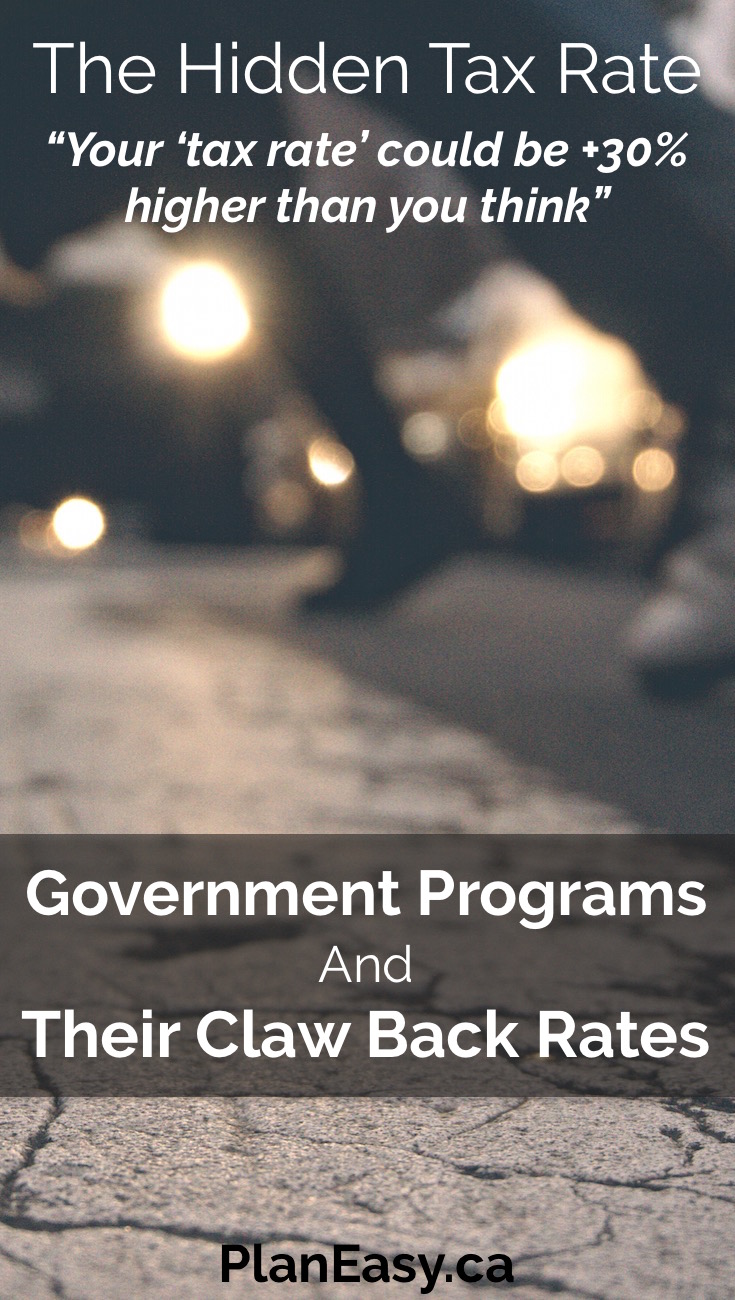The Hidden Tax Rate:
Government Programs And Their Claw Back Rates
There are many government benefit programs that are “income tested”.
You might be asking… “What does “income tested” mean exactly?!?”
This means that the benefits you receive will fluctuate with your net income.
Higher income means lower benefits. Lower income means higher benefits. For low or moderate income households this becomes a very important consideration when creating a financial plan.
At the most extreme, a family with two children earning around $50,000 can expect to lose 32.5% of the next dollar they earn due to these benefit claw backs. This is on top of their marginal tax rate of 29.65%. That means that between claw backs and income taxes over 60% of the next dollar earned will go to the government. Ouch!
While this is an extreme case it does illustrate the impact of these claw backs on certain income levels and family types.
The challenge with these benefits is that the calculation is often not straightforward. Specific rules and claw back rates are often hidden and not easily found. There are also considerations like marital status, number of dependents, disability, income and deductions. This makes it difficult to understand your particular claw back rate.
In addition, many income tested benefits are not based on gross income but on net income, more specifically adjusted family net income (AFNI). In the most basic sense this is your gross income minus any deductions.
One of the most interesting financial planning opportunities this creates is with RRSP contributions.
RRSP contributions are considered a tax deduction and will decrease your net income. This in turn will increase your government benefits. That’s right, the government will increase your benefits today if you save for the future. For low and moderate income households this can sometimes make RRSP contributions more appealing vs TFSA contributions.
This is a BIG post, there are eight government programs we’ll cover.
For each benefit program, we include the benefit amount, the claw back rate and the income level at which the benefit disappears entirely.
Related Posts:
- Optimizing Your Government Benefits: Both Now and In Retirement
- Tax Shelters for Every Canadian
- Did You Know? Your Marginal Effective Tax Rate Could Be 60-70%
Because programs vary by province we’ll look at Federal and Ontario programs only. Each province has similar programs but their rules vary. There are also additional programs available that are not listed here. These are often more unique and not applicable to the majority of people. If you believe a government program should be added please make a comment below or email us at support@planeasy.ca.

Canada Child Benefit:
The Canada Child Benefit (CCB) is one of the largest benefits in Canada and is paid to parents with children under the age of 17. The benefit starts at $6,500/year for each child under 6 and $5,400/year for each child between 6 and 17. The size of this benefit makes it an important consideration for anyone with children under the age of 17.
Benefit reductions start once the family net income crosses $30,000. If you earn even $1 above this threshold your CCB will begin to be reduced.
The rate of reduction depends on the number of children you have. Earnings between $30,000 and $65,000 will decrease the Canada Child Benefit at the following rates…
- 1 Child: 7% reduction
- 2 Children: 13.5% reduction
- 3 Children: 19% reduction
- 4 Children: 23% reduction
In addition to the claw back above, for any earnings above $65,000 the Canada Child Benefit will decrease at the follwing rates…
- 1 Child: 3.2% reduction
- 2 Children: 5.7% reduction
- 3 Children: 8% reduction
- 4 Children: 9.5% reduction
A family with one child under 6, earning $80,000 per year, will see their CCB get reduced by 7% for every dollar between $30,000 and $65,000 and then reduced by 3.2% for every dollar between $65,000 and $80,000. Their benefit would be $6,500 – 7%*($65,000 – $35,000) – 3.2%*($80,000 – $65,000) = $3,570 per year.
Because the CCB is higher for young children the actual income level where CCB disappears entirely will depend on the age of your children. A family with two children under the age of 6 will see their CCB disappear once income crosses $210,175. A family with two children over the age of 6 will see their CCB disappear at $171,579.
Ontario Child Benefit:
Like the Canada Child Benefit, the Ontario Child Benefit is a benefit paid to parents with children under the age of 17. The benefit starts at $1,378/year for each child.
Once family net income crosses $21,037 the benefit is reduced by 8% for each additional dollar earned. For a family with two children the benefit will disappear entirely once income crosses $55,487.
GST/HST Tax Credit:
The Federal GST/HST Tax Credit starts at $280/adult, $280/dependent and $147/child. These benefits are then reduced once family net income crosses a certain threshold.
One interesting thing to note, for a single person household or a single parent household, there is an additional benefit amount that increases with income. This amount is 2% of net income above $9,073 or $147, whichever is lower. As your income increases you gain 2% of every dollar. Once your net income increases past $16,423 your additional benefit will hit the max of $147.
The GST/HST tax credit starts to be reduced once net income crosses $36,429. At this point the credit gets reduced by 5% of every extra dollar.
For a family with two adults and two children the benefit disappears entirely once net income crosses $58,829.
Ontario Property Tax and Energy Credit:
This is a confusing one. The absolute maximum benefit for the Ontario property tax and energy credit is $1,023 for individuals and families and $1,165 for seniors, but your particular maximum will probably be lower, this is because it depends on what you pay for rent and/or property tax.
The Ontario government uses something called occupancy cost (OC) to calculate your benefit. Occupancy cost is either your annual property tax payment or 20% of your annual rent.
For individuals and families, the maximum Energy Credit you can receive is up to $227 or your OC, whichever is lower. The maximum Property Tax Credit you can receive is $56 + 10% of your OC, up to a maximum of $796 or your OC, whichever is lower.
For seniors, the maximum Energy Credit you can receive is up to $227 or your OC, whichever is lower. The maximum Property Tax Credit you can receive is $483 + 10% of your OC, up to a maximum of $938 or your OC, whichever is lower.
Confusing huh?
Benefit reductions start at $22,746 for individuals under the age of 64, $28,433 for single seniors, $28,433 for families, including single parents, and $34,119 for senior couples.
Reduction is 2% of net income above these amounts.
At what income level your benefit disappears entirely will depend on your OC. For someone with an OC of $3,500 (so that is $3,500 per year in property tax or $17,500 per year in rent) the Ontario property tax and energy credit disappears entirely at $54,396 for individuals under the age of 64, $81,433 for single seniors, $60,083 for families, including single parents, and $87,119 for senior couples.

Ontario Sales Tax Credit:
The Ontario Sales Tax Credit starts at $296/adult and $296/child. These benefits are then reduced once family net income crosses a certain threshold.
For a family, married or with children, the sales tax credit is reduced by 4% of each dollar of family net income above $28,433.
For single person household the sales tax credit is also reduced by 4% of each dollar of family net income but this reduction starts when net income crosses $22,746.
For a family with two children the benefit disappears entirely once net income crosses $58,033.
For a single person household this benefit disappears when net income crosses $30,146.
Working Income Tax Benefit:
This is another interesting one. For a small window, the Working Income Tax Benefit (WITB) actually increases as you earn more money. This is basically a negative tax rate. As you earn more the government gives you more money.
For a single person the WITB starts at zero but once your net income cross $3,000 the WITB increases by 25% of every dollar earned until your income crosses $7,112. Once your net income is above $7,112 the WITB maxes out at $1,028.
For a family the WITB increases by 25% of every dollar earned until net income crosses $10,472 at which point the benefit maxes out at $1,868.
For an individual, the benefit remains at the same level until you cross $11,675 in net income. At this point the Working Income Tax Benefit begins to be reduced by 15% of every dollar earned. For an individual, their benefit will be reduced to zero once their net income crosses $18,529.
For a family, this level increases. Only when family net income crosses $16,112 will the WITB begin to be reduced. For a family with two income earners the WITB will disappear entirely at $28,576.
“Higher income means lower benefits. Lower income means higher benefits. This claw back can be as high as 30%+ of each incremental dollar earned.”

Old Age Security (OAS):
Old Age Security (OAS) is available to Canadians over the age of 65. There are some rules around eligibility for Canadians who have lived outside of Canada, residents and citizens need to have lived in Canada for at least 10 years in Canada since the age of 18.
OAS starts at $7,004.88 per person and gets reduced once individual income crosses $74,788. At this point OAS gets reduced by 15% for each incremental dollar in net income. OAS disappears entirely once net income crosses $121,279. For a family with two adults receiving OAS their combined net income could be as high as $149,756 before OAS clawback begins (this assumes perfectly even income splitting).
Guaranteed Income Supplement (GIS):
The Guaranteed Income Supplement (GIS) is actually a subset of the OAS program. It is a unique benefit available to low income seniors. This non-taxable benefit is added to your monthly OAS payments. To qualify for GIS you need to first qualify for OAS.
For single seniors GIS benefits start at $10,494 per year. For a family with two adults GIS starts at $12,634 per year.
In general GIS is clawed back at a rate of 50% for single seniors and 25% for families. But at certain income levels the claw back rate can jump over 100%.
For example, for a single person, between the income levels of $2,088 and $2,096 the GIS claw back rate is 100% and their GIS benefits decrease by $12 per year, essentially canceling out the increase in income.
Another example, for a single person with income between $7,704 and $7,712 the claw back rate is 150%. Annual income increases by $8 but GIS is reduced by $12.
Because the exact calculation for GIS payments is quite complex and the government provides OAS/GIS tables to help seniors estimate their GIS payments at various income levels. If you want to know the exact GIS payment based on your income you should use these tables rather than the general claw back rate.
GIS will disappear entirely for single seniors who have net income above $17,760. For a family with both adults receiving GIS the benefit disappears entirely once net income crosses $23,376. Its important to note that these income levels exclude OAS and GIS payments but include all other payments including CPP.
The Importance Of Claw Backs
Claw backs are an important consideration when making financial decisions as a low or moderate income earner. Financial planning at this income level needs to integrate these programs to provide the best possible advice.
At certain income levels it may make sense to prioritize RRSP contributions due to these claw backs. For certain family types and income levels RRSP contributions could generate a +60% return on each extra $1 in contributions. This is done through a combination of income tax refund and increased benefits.
Getting a +60% return on your savings can be a great motivator and may lead to a higher savings rate. Having a healthy savings rate is an important piece of your overall financial well being.
Join over 250,000 people reading PlanEasy.ca each year. New blog posts weekly!
Tax planning, benefit optimization, budgeting, family planning, retirement planning and more...
Join over 250,000 people reading PlanEasy.ca each year. New blog posts weekly!
Tax planning, benefit optimization, budgeting, family planning, retirement planning and more...






0 Comments
Trackbacks/Pingbacks